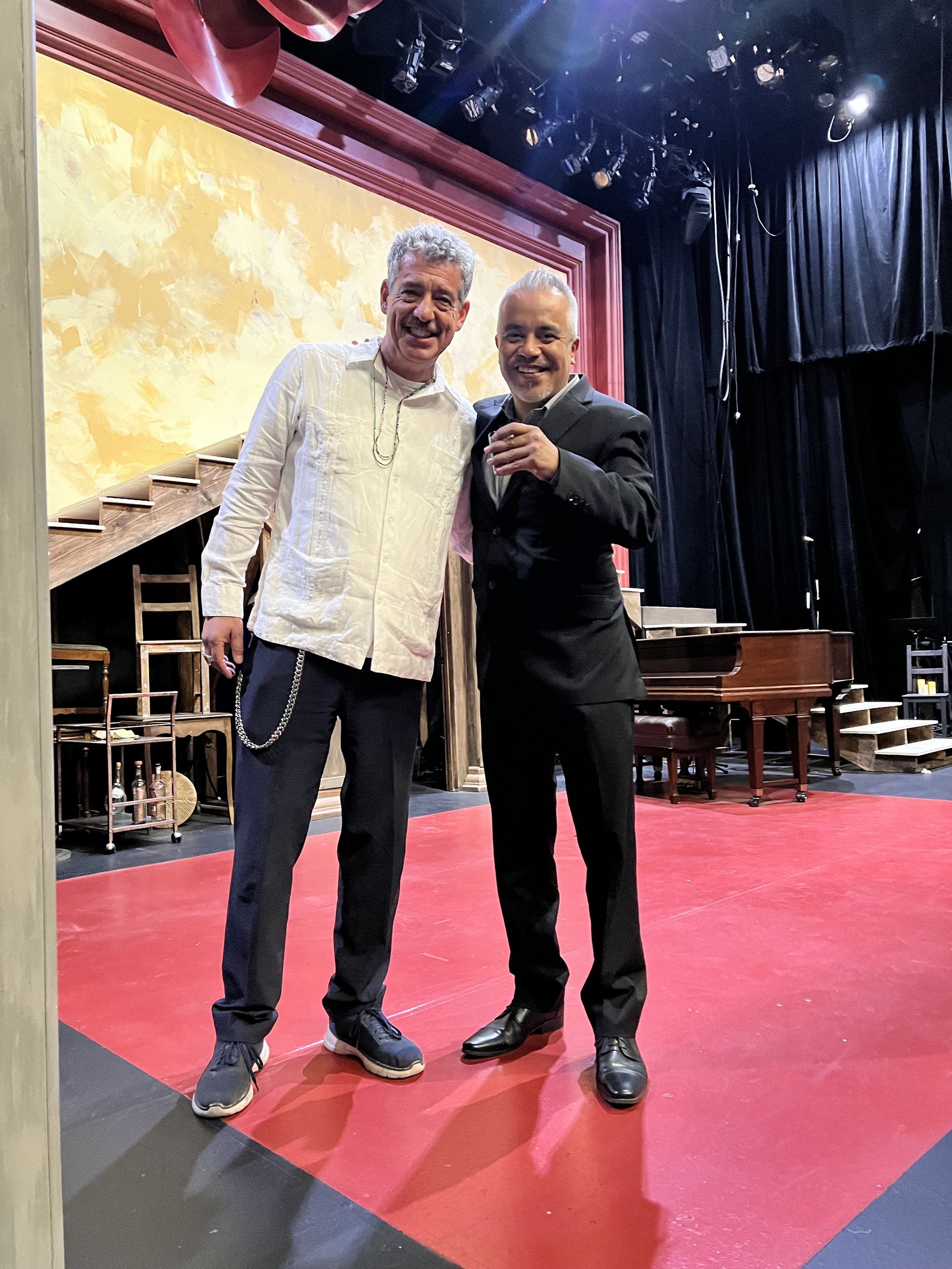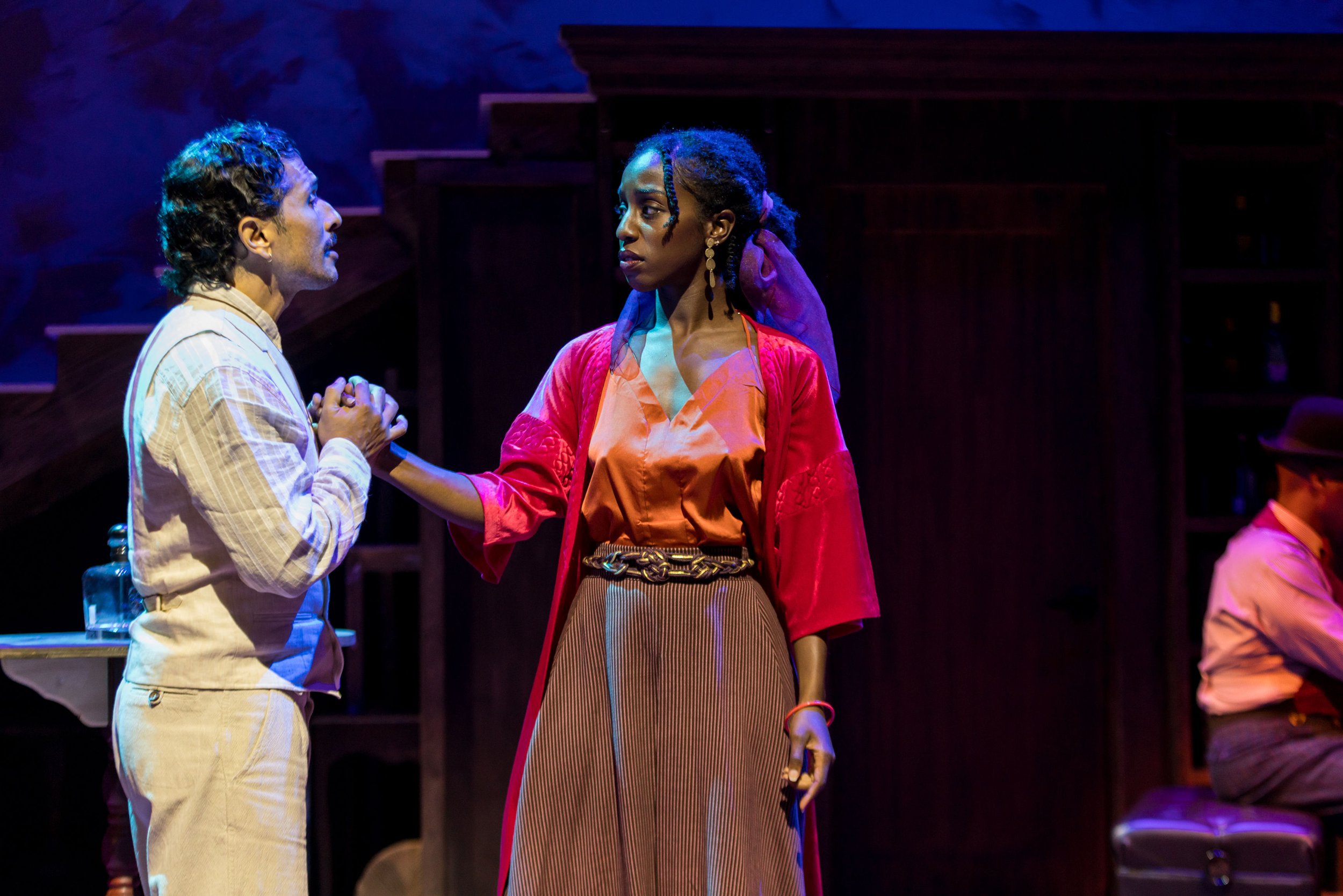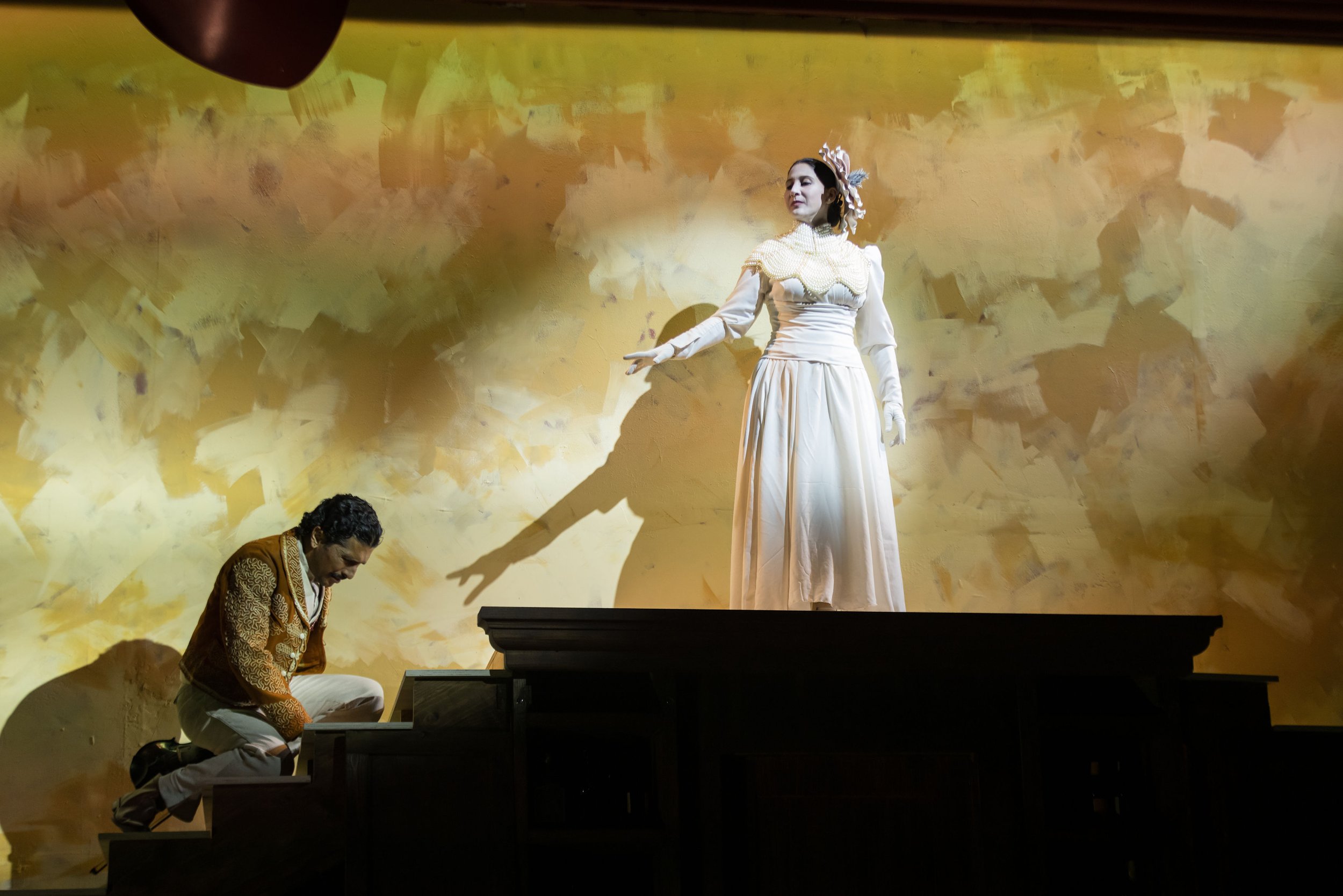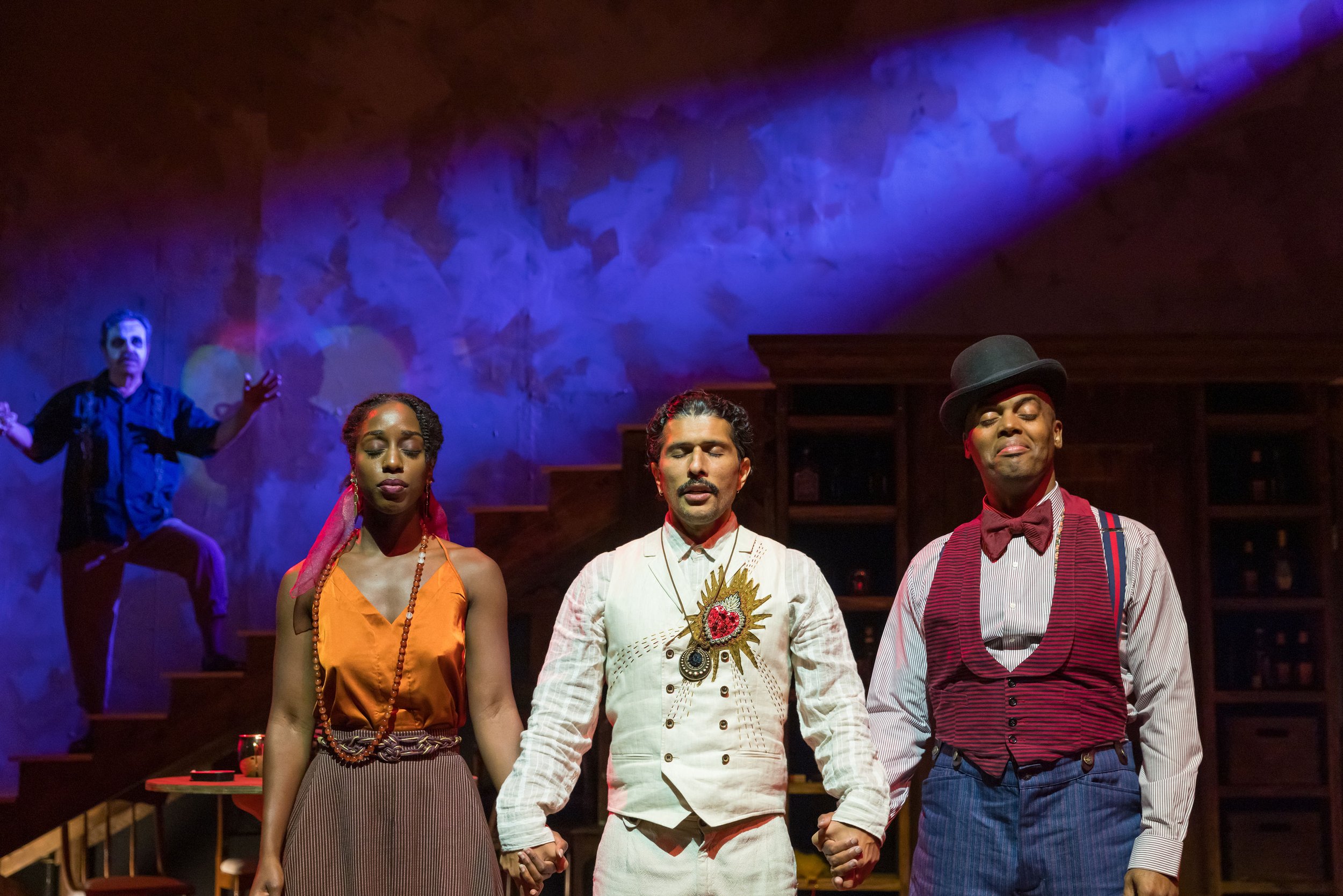Face the Music:
Behind the Script
with Oliver Mayer
By Yazlin Juarez
Award-winning playwright Oliver Mayer opened the Latino Theater Company’s 2024 Spring Season with the world premiere of his latest piece, Ghost Waltz. This historical fiction uncovers the forgotten story of Mexican composer Juventino Rosas, whose iconic waltz Sobre las Olas, also known as “Over the Waves,” has been credited to Johann Strauss. Ghost Waltz made a stunning debut as the second production from the Circle of Imaginistas, a new play commissioning initiative by the Latino Theater Company. Weaving dreams with excerpts from Juventino’s life, Mayer addresses the colorism faced by the musician and the ongoing discrimination of BIPOC (Black/Indigenous/People of Color) artists in the modern day. Waves of USC students, colleagues, and fans of Mayer gathered at the LATC for weeks to support the new production, and left carrying the legacy of Rosas with them.
Mayer recalls the moment he was recruited for the Circle of Imaginistas in 2021, standing in line for a Covid shot at CVS. As a seasoned playwright, Mayer was a close friend of the Latino Theater Company’s power couple: director Jose Luis Valenzuela and playwright Evelina Fernandez. The trio bonded over their love of theater, but rarely got the chance to collaborate on projects, with the exception of Member’s Only directed by Valenzuela in 2018. Mayer was touched by the opportunity to “work something from the ground up with them,” and joined the team as a writer and mentor to Joel Ulloa, author of Tacos La Brooklyn.
The Circle of Imaginstias operates through a commissioning process, in which emerging and established playwrights are given inspiration packages developed by the Latino Theater Company. Mayer was moved by Sal Lopez’s presentation on the late musician Juventino Rosas, which brought Lopez to tears. Though Mayer intended to write a different play for the Imaginistas, he was swept away by a vivid dream of Juventino in huaraches, wearing white, dancing to a waltz. Mayer leapt out of bed in the middle of the night and wrote the first page of the play based on the dream; when morning came the next day, it was clear that this would be his new project.
Though the inspiration was clear, recreating the story of a 19th century musician with hardly any documentation was no easy task. Mayer sought to create a cast that would appeal to modern audiences and last the test of time. How do you turn elusive historical figures into fully-fleshed out characters? Mayer’s philosophy is that “writing plays is like playing God.” Like many artists, he draws inspiration from his own experiences to create an alternate version of himself. In fact, Mayer claims he injects “a little bit of his DNA” into every character he creates, as if they were his children. You give them life, created in your own image, but once you set them free into the world, they are no longer yours. They will continue to grow and evolve despite what you had planned, but you may be pleasantly surprised by the results.
Every playwright prays that they will find the right actor to bring this vision to life, and luckily, fate brought Mayer the perfect embodiment of Juventino Rosas: Quetzal Guerrero. The rest of the pieces fell into place after Nathalie Peña-Comas agreed to play the revered opera singer Ángela Peralta, also known as “The Mexican Nightingale,” joined by Ric’Key Pageot as African-American ragtime genius Scott Joplin. Watching the actors and musicians’ synergy on stage was like stepping into the 1800s and meeting these creative geniuses on the verge of greatness, held back by the hardships they shared as non-white artists. “If I bring [Juventino] back to life, if I allow him to live again, maybe we begin to take some inspiration from him in all kinds of ways. Maybe it's music, maybe it's artwork, maybe it's just loving people.”
Although Rosas never received proper recognition during his life, eventually selling the rights of his beloved waltz to leading music publisher Casa Wagner y Levien, he lives on as an inspiring figure in Mexican history. As a working-class, dark-skinned man of Otomí descent, Rosas broke barriers and became one of the first Indigenous students at the National Conservatory of Music in Mexico City. Peralta, a fellow Indigenous music student, becomes a foil to the optimistic Rosas, as she hides her dark skin under white makeup to succeed in the industry. This is a painful reminder of skin-whitening still practiced in Mexico and other countries around the globe affected by colorism: a system of social hierarchy propagated by white supremacy that praises European features and punishes ethnic features. Despite her disdain for Rosas, Mayer never intended for her to be the villain, rather a reflection of resilient women of color fighting for a career. “No matter what we put on our skin, or what has been put on us, or how people view us underneath it, we’re human. Talented and complex and full of surprises.”
“No matter what we put on our skin, or what has been put on us, or how people view us underneath it, we’re human. Talented and complex and full of surprises.”
Mayer thought it was important to address the complexity of Mexico’s cultural landscape to understand the conditions that led to Rosas’ music career and the impact on Latine audiences today. A large percentage of Mexicans and Mexican-Americans identify as having both Indigenous and European ancestry as a result of colonization. The culture of mestizaje – a term for mixed ethnic ancestry originating from the racial caste system imposed by Spanish colonizers – leaves millions of Latines to reckon with the grim past of their heritage. The equation becomes even more complicated after considering the waves of German and Austrian immigrants and Mexico’s foreign policy that brought polka and waltz music, resulting in beloved Mexican genres like banda. Although European culture was introduced to the Americas through violence, their presence remains in many aspects of Mexican culture that we find comfort in. Mayer encourages Mexicans to make peace with their European sides as “part of our cultural bloodline,” and turn the power dynamics from one of anger to one of love and acceptance.
As a fellow artist, Mayer embeds his own creative process into Rosas as he finds inspiration through love and continues to write the famous waltz over the course of the play. Striding across stage with a wave of his bow, Rosas emits an enchanting melody, and then stops. As if stuck in a dream, or a time loop, he repeats a familiar line: “I can almost hear it. It’s on the tip of my mind.” Both Mayer and Rosas understand the feeling of being consumed by their art, but in the end, you cannot run from your calling. Mayer insists that when you are writing, “you have to get swept away. When you are swimming in the Pacific, and you get knocked down by those forces and pulled under, you have to fight to get back breathing…” And yet, this is exactly the kind of chaos that he thrives in. “The product itself is, of course, something to celebrate, but you gotta love the process, you gotta love the doing, and that will always sweep me off my feet.”
As a dramatic arts professor at USC, Mayer considers himself a mentor at heart. He names Luis Valdez as his first mentor, also known as “the godfather of Chicano theater,” simply for creating Zoot Suit and setting an example for the young playwright. The greatest piece of advice Mayer received from his writing mentors was that “If a [script] is any good, it’s like a bird in flight. It’s really hard to catch a bird, so you have to really want to, and you could hurt it if you do so you have to be really careful… if you want to keep it alive, you have to move with it.” Mayer used this fluid approach to writing Juventino’s character and honoring his spirit because although he is not alive, he is still very present with us.
“If a [script] is any good, it’s like a bird in flight. It’s really hard to catch a bird, so you have to really want to, and you could hurt it if you do so you have to be really careful… if you want to keep it alive, you have to move with it.”
Mentoring Joel Ulloa marked a new chapter in Mayer’s career, which gave him the opportunity to collaborate on revolutionary works and carve new paths to success for future playwrights. “[The Latino Theater Company] allowed 11 writers to do it our way, and when we do that, then we influence 11 directors and any number of cast members and designers, and eventually audiences, to think about another way seeing plays and being a part of plays and hopefully writing their own plays down the road.” Though Mayer and Ulloa were the Circle of Imaginistas’ first “guinea pigs,” both of their works were well received and promise a bright future for the playwright’s circle. Mayer smiles, “It’s an auspicious beginning for a playwright. I can’t wait to see what [Joel] does next.”
After the loss of his comadres while writing Ghost Waltz, Mayer was inspired to incorporate Rosas’ father, his Austrian music mentor, and a witch doctor as spirit guides. The play uses these spirit guides as a buffer between the land of the dead and the living, the past and present, fiction and reality. At the end of the story, Rosas breaks the 4th wall to reunite with his ghostly guides, and reflect on the legacy he has left upon the Mexican-American diaspora. Though his work is not widely known, Mayer considers Rosas as one of the greats, a talent like Jimmy Hendrix or Janice Joplin — taken too soon, and given too little. “It's important that legacy belongs to everyone, not just the biggest, most famous writers or actors or artists…” says Mayer. “Everyone has a legacy and that's a good thing, it makes us better. Your legacy makes me better.”
“It's important that legacy belongs to everyone, not just the biggest, most famous writers or actors or artists…” says Mayer. “Everyone has a legacy and that's a good thing, it makes us better. Your legacy makes me better.”
Rosas’s story has found an audience once more, as Mayer’s play has been selected to tour throughout Mexico with producer Ruben Islas at Grand Ave International, directed by Alberto Barboza and translated by Lucia Leonor Enriquez. The tour premiers in March 2025 at the Angela Peralta Teatro – an opera house in Mazatlán, Sinaloa where The Mexican Nightingale once performed – under the play’s Spanish title, Vals entre las Sombras.
In the spirit of Juventino Rosas, Mayer encourages artists to face the ocean of inspiration and emerge with something new, something immortal. Reviving the life of a legendary artist for a new generation has given Mayer a new reason to write: to resist the erasure of BIPOC artists and reassert our presence in the global theater scene. “We're still here,” he proclaims. “We're still here, and we have something to say and something to give.”
“We're still here, and we have something to say and something to give.”


















Oliver Mayer is a playwright, poet, essayist, and tenured professor at USC's School of Dramatic Arts. He is also a proud member of The Latino Theater Company's Circle of Imaginistas. Born and bred in LA, at age 11 he saw the original production of Zoot Suit and it changed his life. He has spent the bulk of his artistic life writing, mentoring, and being mentored by his fellow committed theatre artists, with hopefully no end in sight. Besides Blade To The Heat, Oliver has well over 30 original plays -- two of which were produced at the LATC -- Joe Louis Blues in 1992, and Members Only in 2018. With composer Jenni Brandon, he wrote the libretto to the opera 3 Paderewskis, which received its world premiere at The Kennedy Center. In his work, he links arms with Lorca, Saroyan, Brecht and Valdez, and surfs the sounds and spirit of Marvin Gaye, JS Bach, Silvio Rodriguez, Jackie Wilson, and -- now -- Juventino Rosas and Scott Joplin. Ghost Waltz is dedicated to all those recovering our stories from beneath the whitewash. And, as always, is para mi mas bella flor.
Yazlin Juarez is a writer and multidisciplinary artist based in Pico Rivera. She takes every opportunity to forge spoken word poetry, photography, and design into instruments of social change. Yazlin discovered her love of theater through the Cultural Arts and Diversity Resource Center, where served as the Poet’s Corner director. She is published in the Red Wheelbarrow Anthology, TWANAS Press, PubLab, and Stage Raw and continues to capture her history from a queer Chicana lens.
📸 Ghost Waltz, 2024 Production Photos by Grettel Cortes Photography





